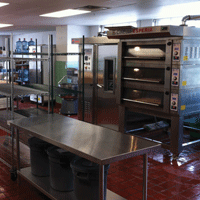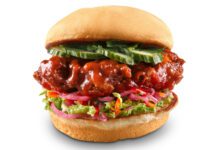Operators, from Hawksworth to Walshand Lettieri, weigh in on their kitchen must-haves
John Placko merely opens his closet door to access his stockpile of goodies. In fact, the director of Culinary Excellence for ThinkFood Culinary and Innovation Centre at Maple Leaf Foods in Mississauga, Ont., has a veritable emporium of kitchen equipment on wheels that he uses for food-prep demos.
“Chargrills, stoves, combi-therms, accelerated cooking ovens, salamanders, deep fryers, rotisseries ovens, steam kettles, commercial and domestic ovens, mixers, bread slicers,” he lists. “There’s not much we don’t have.”
Placko’s audience is equally diverse, from restaurant and chain operators, to healthcare, retirement home and contract catering chefs. So when it comes to knowing what makes chefs tick, and how to choose the best equipment, he probably has the answer. “It’s about getting a reputable supplier, longevity and a good maintenance program,” he says. “Of course, everyone is looking at energy efficiency, and, depending on the type of operation, there’s a growing interest in multi-function equipment like combi-ovens, touchscreen technologies and preprogramming capabilities for one-touch cooking.”
Where chefs can indulge in more creative play, Placko sees more uptake of versatile appliances such as the Pacojet micro-purée system for frozen items; and the Thermomix multi-purpose food processor for sauces and risotto. “I don’t see sous vide slowing down either,” he adds. “With vacuum sealers and thermal circulators, you can get a better yield, accuracy and consistency.”
David Wilson, corporate chef for W.D. Colledge, a manufacturers’ representative in Toronto, says growth of combi-oven and accelerated cooking technologies is especially strong. “Fast-food chains, grocery stores and institutions are looking for equipment that can cook food quickly and consistently and doesn’t require a lot of skill set to run. Institutional organizations favour the technology because it has an increased yield, can be preprogrammed and helps meet HACCP (Hazard Analysis and Critical Control Points) requirements.”
Ask individual industry operators about their favourite workhorses or widgets, and you’ll find the answers can be as varied as Placko’s appliance closet.
THE FAST LANE
At QSR operations such as Extreme Brandz, it’s the smaller equipment pieces that can make the biggest difference.
Buying equipment is pretty much an ongoing job at the network of 260 (and growing) Extreme Pita and Mucho Burrito restaurants throughout Canada and the U.S. “We look for quality in products that can stand abuse,” says Alex Rechichi, president and CEO of the Mississauga, Ont.-based parent company, Extreme Brandz. “We also want pieces that don’t have extensive maintenance requirements, are simple to use and don’t need a lot of programming.”
Generally speaking, the “equipment package” for each location is not extensive. “We don’t have large ovens or steamers, because a lot of our food is prepared fresh — standard charbroilers and griddles are the essential pieces,” says the CEO.
He sources most of his equipment from the St. Louis-based Star Manufacturing International, Inc. “I’d say each is roughly around $300 to $400 depending on the size of the unit,” he says of his griddles and charbroilers. Rechichi’s griddle of choice for Extreme Pita is a chromium top number that doesn’t retain carbon and turn surfaces black. “Non-chromium is probably half the price, but we’re focused on cooking surfaces that look and stay clean and can handle the volumes.”
Food displays are also an important part of the picture at the QSR company. Rechichi uses display units from True Refrigeration for his Extreme Pita locations. On the Mucho Burrito side, he opts for custom-made cold-counter displays, because layout differs from unit to unit.
When it comes to picking his faves, John Lettieri is of two minds. That’s because he’s the owner of the Toronto-based Lettieri Espresso Bar + Café and Hero Certified Burgers chains. “With a café, you need to provide as much hands-on service as possible. However, we also look at anything that will allow us to get a bit more efficient and take the onus off the operators and staff.”
He’s been loyal to his Florence, Italy-designed La Marzocco espresso machines since day one. Prices vary from $15,000 to $25,000, depending on the store location. The only change has been the addition of Swift automatic grinders to eliminate the need to manually press the grounds by hand.
Another must-have is the Moretti fully stone baked ovens. At $25,000, Lettieri has only installed two to date. And, he is trying out a fully integrated stainless steel/glass/leather modular in-store counter system from Ifi in Italy; it includes a hot table, espresso bar as well as ice cream and cash counters.
With Hero, beyond a point-of-sale system, equipment needs are completely different than the café. Fryers, grills and charbroilers are par for the course — except in locations within residential buildings.
“We have added soft-serve ice-cream machines from Taylor; and we’ve also put in ecological air filtration units to stop odours in the atmosphere, including units from Oil Screen, Captive Aire, Spring Air and Halton.”
ALL IN THE FAMILY
When it comes to cooking for the mid-scale market at Joey Restaurant Group, constant expansion means Chris Mills, the chain’s Vancouver-based executive chef, is constantly scouting new tools. One of the biggest workhorses in the chef’s kitchens is a copper- cored griddle from the Vancouver-based Quest Metal Works Ltd., which rings in at $12,000. “The half-inch copper core gives edge-to-edge even heat without hot spots.”
A signature item at the newest and largest Joey Restaurant location in Toronto’s Eaton Centre is the $10,000-plus Enomatic wine system unit that uses inert gas to keep wine fresh longer. “We were the first to bring it to restaurants in Canada. We just installed a round one … that’s a show stopper,” Mills says.
Like many chefs these days, combi-ovens are one of Mills’ prized pieces. One of his favourites is a new Alto-Shaam combi-oven that does real wood-chip smoking. At $20,000 a unit, these versatile machines are only used in the Toronto and Vancouver restaurants. “We’ve dabbled with smokers before, but they were highly inefficient,” the toque says. “This technology is simple and works well.”
THE FINER THINGS
Equipment trends in fine dining can be a completely different kettle of fish, says Anthony Walsh, corporate executive chef of Oliver & Bonacini Restaurants in Toronto.
For Walsh, the lion’s share of the work in the company’s higher-end locations, such as Canoe and Biff ’s Bistro, is done with thermal circulators from PolyScience. “We use them all over the place. The latest digital ones are a bit tougher and lower cost at under $1,000. The upside is you have them cooking 24 hours a day. You just have to be careful [you have a controlled environment ] when cooking things at lower temperatures and holding them longer. Now with even the slightest blip in the temperature you can be alerted via email — that’s pretty cool.”
O&B’s Cryovac vacuum-sealing system costs an additional $3,000 to $5,000. “It’s not cheap. But you not only get significantly more intense flavour, it creates a lot less waste, is less messy to work with, takes up less space and increases consistency — a huge plus is the labour and real-estate savings. But you definitely need one with a good enough motor and programmable capabilities.”
A recent feather in Walsh’s toque is a new Cinelli rotating oven, which bakes croissants and breads. This $30,000 behemoth is big enough to stand inside, he says. “We can do in excess of 3,500 boules, 450 to 500 loaves a night.”
David Hawksworth, chef and owner of the new Hawksworth Restaurant in Vancouver believes in custom accoutrements all the way, from specially designed Garland ranges for the garnish area, to the sleek, stainless steel surfaces and cabinets. “There’s not a kitchen like this that I’ve ever seen in Canada,” he says. “All the refrigeration, worktops, tables and chairs were designed to our own specifications.”
Hawksworth didn’t take any shortcuts. “We’ve got lots of custom countertops. We also stick to solid stove tops — no open-flame burners.” The impressive stainless steelwork in this award-worthy kitchen is courtesy of Quebec’s Sani Métal Lté.
For smaller grilling jobs, Hawksworth opted for CVap hold-and-serve drawers from Winston. He also uses a Thermomix for sauces and eye-catching cobalt blue Le Creuset pots and pans. Like Walsh, Hawksworth also has multiple PolyScience circulators for sous-vide cooking.
Meanwhile, John Higgins director of George Brown Chef School is always looking for items that can add extra cachet to the college’s Chef’s House restaurant. He’s currently into canning and preserving. “People are looking for artisan-type products that are different,” he explains. It’s a job that requires a $7,000 investment, including a metal detector. “Preserving is a big thing, but it’s essential you don’t contaminate the product. The cost of the machinery is nothing compared to the damage to your brand if something goes wrong.”
Depending on budgets and clientele, selecting the right equipment for success can be both an art and a science. Whatever the type of operation and the size of the item in question however, it’s consistency and quality of output that ultimately wins the day.
For a complete kitchen equipment supplier’s list, please visit our Buyer’s Guide.
More in Feature Articles:
Key to Foodservice Success: Find and Retain Top-Notch Staff
Rising to The Challenge: Discovering New Grains for Your Foodservice Operation
Au Natural: Consumers Embrace Juice and Pop Based Drinks





















